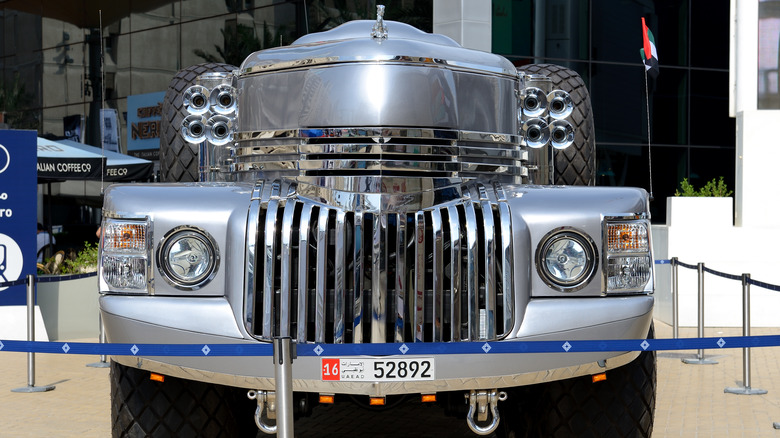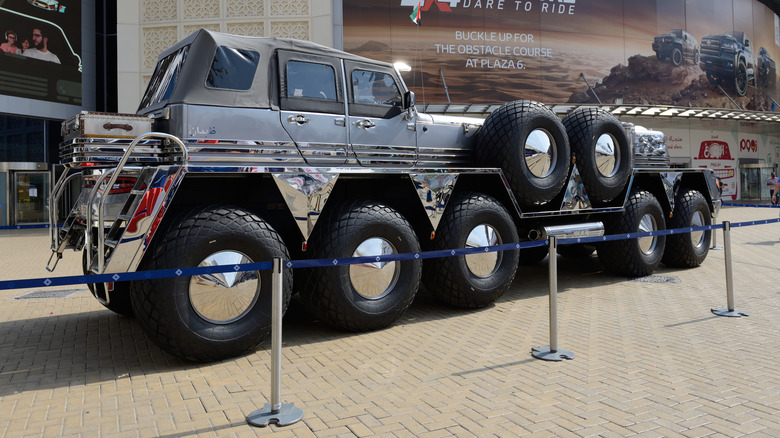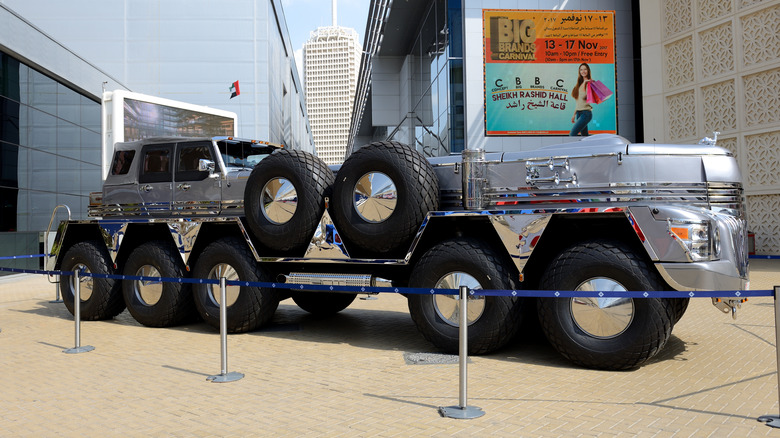The World's Biggest SUV Is A Beast
The United Arab Emirates is a nation not known for automotive understatement. In a country boasting some of the rarest rides and most rabid car collectors in the world, it's tough to do something new. Every fresh acquisition has to contend with mad motor spectacles, ones ranging from Zarooq's 518-horsepower Sandracer luxury dune buggy to police cars that appear to be from the future and what may be the first road-legal solar-powered car (via Khaleej Times). In short, serious car fans in the UAE have to work hard to turn heads. Even Sheikh Hamad bin Hamdan Al Nahyan, the "Rainbow Sheikh" who picked up his nickname because he owns a Mercedes S-Class for every color in the visible spectrum, has to go quite a ways to stand out from the crowd.
The Dhabiyan, a 35-foot, 10-wheeled automotive chimera that was hacked together from several different commercial and military vehicles has already collected both fans and detractors. The vehicle has been called everything from a desert ship to a useless eccentricity. Whether a given observer rates the Dhabiyan as a no-expense-spared masterpiece or a pointless, overdesigned indulgence, everyone who has seen the vehicle agrees on one thing: Sheikh Hamad's Dhabiyan, given its civilian ownership and off-road capability, is almost certainly the single largest SUV in the world.
How, why and whither the Dhabiyan?
The Sheikh's desert ship didn't spring fully grown from the sand, of course. The Dhabiyan is something of an automotive turducken — that is, it's the result of master engineers following the Sheikh's own designs and sticking together multiple vehicles, including a Jeep Wrangler, a Dodge Dart, a Ford Super Duty, and, crucially, an Oshkosh M1075 military truck into a single glorious monstrosity. The madness begins with the Oshkosh and its original military-specification 12.5-ton Caterpillar engine, which comes with a massive 600 brake horsepower.
The M1075 military truck provides much of the bare bones of the Dhabiyan, including the drivetrain and its five axles. The components of the Dhabiyan not taken from the truck are mostly, for lack of a better word, cosmetic. The Sheikh clearly wanted his ride to be visibly a car, not just somebody else's truck in drag. The Sheikh designed the Dhabiyan's driver's cabin out of most of a Jeep Wrangler. He and his mechanics worked out the back end from a classic Dodge Dart. Headlights and other modifications up front are a mashup of a Super Duty pickup and an unnamed 1940s truck (via TimesNow News).
The result is less a sensible mode of transport than a 10-wheeled fever dream, to be sure, sort of a permanent collision between a military exhibition and a parade float. That said, the Dhabiyan is a working vehicle capable of tackling asphalt and sand with equal aplomb. Someone call George Miller — given that another bit of beautiful Emirati madness recently starred in "Furious 7," we think we have an idea for the next "Mad Max."
The Desert Ship (that rarely goes outdoors)
The Dhabiyan purports to be a "desert ship." It's tempting — and may well be intentional — to see the vast vehicle in those terms: as a 21st-century descendant of the dhows and mighty caravans that crossed the world throughout the history and mythology of the Arabic-speaking world. History and myth are both vital elements of noble identity, and Hamad bin Hamdan Al Nahyan, The Rainbow Sheikh, is clearly crafting his own.
Looking at the vehicle in terms of engineering and modern history, however, reveals interesting elements of the role played by the Dhabiyan, the Sheikh, and the UAE on the world stage. It may be hard to believe, but larger trucks than the Dhabiyan are to be found elsewhere in the Middle East — real American Oshkosh M1075s, doing their original job of transporting tanks to war zones. The Dhabiyan is actually lighter than the original truck despite all the extra bodywork (via Military Today) — after all, it no longer needs to be hardened for wartime service.
Since its construction, TripAdvisor shows the Dhabiyan has spent much of its time inside or in controlled environments, entertaining crowds of onlookers rather than carving new paths through the desert. Instead of a massive military workhorse, the Dhabiyan is something closer to a traveling show, a closer cousin to this swimming pool than anybody's tank. It's a demonstration of what's possible when military-caliber engineering meets Defense Department money in peacetime. The thing might be a silly, self-indulgent flex, but that beats blowing people up any day.


